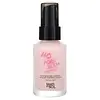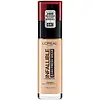What's inside
What's inside
 Key Ingredients
Key Ingredients

 Benefits
Benefits

 Concerns
Concerns

 Ingredients Side-by-side
Ingredients Side-by-side

Cyclopentasiloxane
EmollientWater
Skin ConditioningDimethicone
EmollientDimethicone/Vinyl Dimethicone Crosspolymer
Skin ConditioningPEG-10 Dimethicone
Skin ConditioningDimethicone Crosspolymer
Emulsion StabilisingDipropylene Glycol
HumectantSilica
AbrasivePhenoxyethanol
PreservativeDisteardimonium Hectorite
StabilisingMagnesium Sulfate
Parfum
MaskingMethyl Methacrylate Crosspolymer
CI 77891
Cosmetic ColorantEthylhexylglycerin
Skin ConditioningDisodium EDTA
Aluminum Hydroxide
EmollientStearic Acid
CleansingButylene Glycol
HumectantCI 77491
Cosmetic ColorantSoluble Collagen
HumectantCI 73360
Cosmetic ColorantCamellia Sinensis Leaf Extract
AntimicrobialTriethoxycaprylylsilane
Cyclopentasiloxane, Water, Dimethicone, Dimethicone/Vinyl Dimethicone Crosspolymer, PEG-10 Dimethicone, Dimethicone Crosspolymer, Dipropylene Glycol, Silica, Phenoxyethanol, Disteardimonium Hectorite, Magnesium Sulfate, Parfum, Methyl Methacrylate Crosspolymer, CI 77891, Ethylhexylglycerin, Disodium EDTA, Aluminum Hydroxide, Stearic Acid, Butylene Glycol, CI 77491, Soluble Collagen, CI 73360, Camellia Sinensis Leaf Extract, Triethoxycaprylylsilane
Ethylhexyl Methoxycinnamate 6.743%
UV AbsorberTitanium Dioxide 3.591%
Cosmetic ColorantWater
Skin ConditioningDimethicone
EmollientIsododecane
EmollientAlcohol Denat.
AntimicrobialButylene Glycol
HumectantTrimethylsiloxysilicate
EmollientPEG-10 Dimethicone
Skin ConditioningPerlite
AbsorbentSynthetic Fluorphlogopite
Nylon-12
Isopropyl Lauroyl Sarcosinate
Skin ConditioningDiisopropyl Sebacate
EmollientDisteardimonium Hectorite
StabilisingHdi/Trimethylol Hexyllactone Crosspolymer
Bis-PEG/PPG-14/14 Dimethicone
EmollientMagnesium Sulfate
Aluminum Hydroxide
EmollientPhenoxyethanol
PreservativeDisodium Stearoyl Glutamate
CleansingHydrogen Dimethicone
Dipentaerythrityl Tetrahydroxystearate/Tetraisostearate
Skin ConditioningParfum
MaskingSilica Silylate
EmollientAcrylonitrile/Methyl Methacrylate/Vinylidene Chloride Copolymer
Tocopherol
AntioxidantHexyl Cinnamal
PerfumingSilica
AbrasiveIsobutane
Benzyl Salicylate
PerfumingLinalool
PerfumingAlpha-Isomethyl Ionone
PerfumingBenzyl Alcohol
PerfumingBHT
AntioxidantCitronellol
PerfumingIron Oxides
CI 77510
Cosmetic ColorantEthylhexyl Methoxycinnamate 6.743%, Titanium Dioxide 3.591%, Water, Dimethicone, Isododecane, Alcohol Denat., Butylene Glycol, Trimethylsiloxysilicate, PEG-10 Dimethicone, Perlite, Synthetic Fluorphlogopite, Nylon-12, Isopropyl Lauroyl Sarcosinate, Diisopropyl Sebacate, Disteardimonium Hectorite, Hdi/Trimethylol Hexyllactone Crosspolymer, Bis-PEG/PPG-14/14 Dimethicone, Magnesium Sulfate, Aluminum Hydroxide, Phenoxyethanol, Disodium Stearoyl Glutamate, Hydrogen Dimethicone, Dipentaerythrityl Tetrahydroxystearate/Tetraisostearate, Parfum, Silica Silylate, Acrylonitrile/Methyl Methacrylate/Vinylidene Chloride Copolymer, Tocopherol, Hexyl Cinnamal, Silica, Isobutane, Benzyl Salicylate, Linalool, Alpha-Isomethyl Ionone, Benzyl Alcohol, BHT, Citronellol, Iron Oxides, CI 77510
Ingredients Explained
These ingredients are found in both products.
Ingredients higher up in an ingredient list are typically present in a larger amount.
Aluminum Hydroxide is a form of aluminum. It can be naturally found in nature as the mineral gibbsite. In cosmetics, Aluminum Hydroxide is used as a colorant, pH adjuster, and absorbent.
As a colorant, Aluminum Hydroxide may add opacity, or reduce the transparency. Aluminum hydroxide is contains both basic and acidic properties.
According to manufacturers, this ingredient is an emollient and humectant. This means it helps hydrate the skin.
In medicine, this ingredient is used to help relieve heartburn and help heal ulcers.
There is currently no credible scientific evidence linking aluminum hydroxide in cosmetics to increased cancer risk.
Major health organizations allow the use of aluminum hydroxide in personal care products and have not flagged it as a carcinogenic risk at typical usage levels.
Learn more about Aluminum HydroxideButylene Glycol (or BG) is used within cosmetic products for a few different reasons:
Overall, Butylene Glycol is a safe and well-rounded ingredient that works well with other ingredients.
Though this ingredient works well with most skin types, some people with sensitive skin may experience a reaction such as allergic rashes, closed comedones, or itchiness.
Learn more about Butylene GlycolDimethicone is a type of synthetic silicone created from natural materials such as quartz.
What it does:
Dimethicone comes in different viscosities:
Depending on the viscosity, dimethicone has different properties.
Ingredients lists don't always show which type is used, so we recommend reaching out to the brand if you have questions about the viscosity.
This ingredient is unlikely to cause irritation because it does not get absorbed into skin. However, people with silicone allergies should be careful about using this ingredient.
Note: Dimethicone may contribute to pilling. This is because it is not oil or water soluble, so pilling may occur when layered with products. When mixed with heavy oils in a formula, the outcome is also quite greasy.
Learn more about DimethiconeDisteardimonium Hectorite comes from the clay mineral named hectorite. It is used to add thickness to a product.
It can also help stabilize a product by helping to disperse other ingredients.
Hectorite is a rare, white clay mineral.
Learn more about Disteardimonium HectoriteMagnesium Sulfate is a salt. More specifically, it is an epsom salt, or the bath salt used to help relieve muscle aches.
Despite having ‘sulfate’ in the name, it isn’t a surfactant or cleansing agent like sodium lauryl sulfate. Unlike those sulfates, magnesium sulfate doesn’t have the same cleansing or foaming properties (it's simply a type of salt).
In cosmetics, Magnesium Sulfate is used to thicken a product or help dilute other solids. It is a non-reactive and non-irritating ingredient.
One study shows magnesium deficiency may lead to inflammation of the skin. Applying magnesium topically may help reduce inflammation.
You can find this ingredient in sea water or mineral deposits.
Learn more about Magnesium SulfateParfum is a catch-all term for an ingredient or more that is used to give a scent to products.
Also called "fragrance", this ingredient can be a blend of hundreds of chemicals or plant oils. This means every product with "fragrance" or "parfum" in the ingredients list is a different mixture.
For instance, Habanolide is a proprietary trade name for a specific aroma chemical. When used as a fragrance ingredient in cosmetics, most aroma chemicals fall under the broad labeling category of “FRAGRANCE” or “PARFUM” according to EU and US regulations.
The term 'parfum' or 'fragrance' is not regulated in many countries. In many cases, it is up to the brand to define this term.
For instance, many brands choose to label themselves as "fragrance-free" because they are not using synthetic fragrances. However, their products may still contain ingredients such as essential oils that are considered a fragrance by INCI standards.
One example is Calendula flower extract. Calendula is an essential oil that still imparts a scent or 'fragrance'.
Depending on the blend, the ingredients in the mixture can cause allergies and sensitivities on the skin. Some ingredients that are known EU allergens include linalool and citronellol.
Parfum can also be used to mask or cover an unpleasant scent.
The bottom line is: not all fragrances/parfum/ingredients are created equally. If you are worried about fragrances, we recommend taking a closer look at an ingredient. And of course, we always recommend speaking with a professional.
Learn more about ParfumPeg-10 Dimethicone is silicone with conditioner and emulsifier properties. It mostly acts as an emollient in skincare and and humectant in haircare.
According to the manufacturer, acidic formulations decrease the stability of this ingredient. It works best in neutral or near neutral formulations.
Phenoxyethanol is a preservative that has germicide, antimicrobial, and aromatic properties. Studies show that phenoxyethanol can prevent microbial growth. By itself, it has a scent that is similar to that of a rose.
It's often used in formulations along with Caprylyl Glycol to preserve the shelf life of products.
Silica, also known as silicon dioxide, is a naturally occurring mineral. It is used as a fine, spherical, and porous powder in cosmetics.
Though it has exfoliant properties, the function of silica varies depending on the product.
The unique structure of silica enhances the spreadability and adds smoothness, making it a great texture enhancer.
It is also used as an active carrier, emulsifier, and mattifier due to its ability to absorb excess oil.
In some products, tiny microneedles called spicules are made from silica or hydrolyzed sponge. When you rub them in, they lightly polish away dead skin layers and enhance the penetration of active ingredients.
Learn more about SilicaWater. It's the most common cosmetic ingredient of all. You'll usually see it at the top of ingredient lists, meaning that it makes up the largest part of the product.
So why is it so popular? Water most often acts as a solvent - this means that it helps dissolve other ingredients into the formulation.
You'll also recognize water as that liquid we all need to stay alive. If you see this, drink a glass of water. Stay hydrated!
Learn more about Water